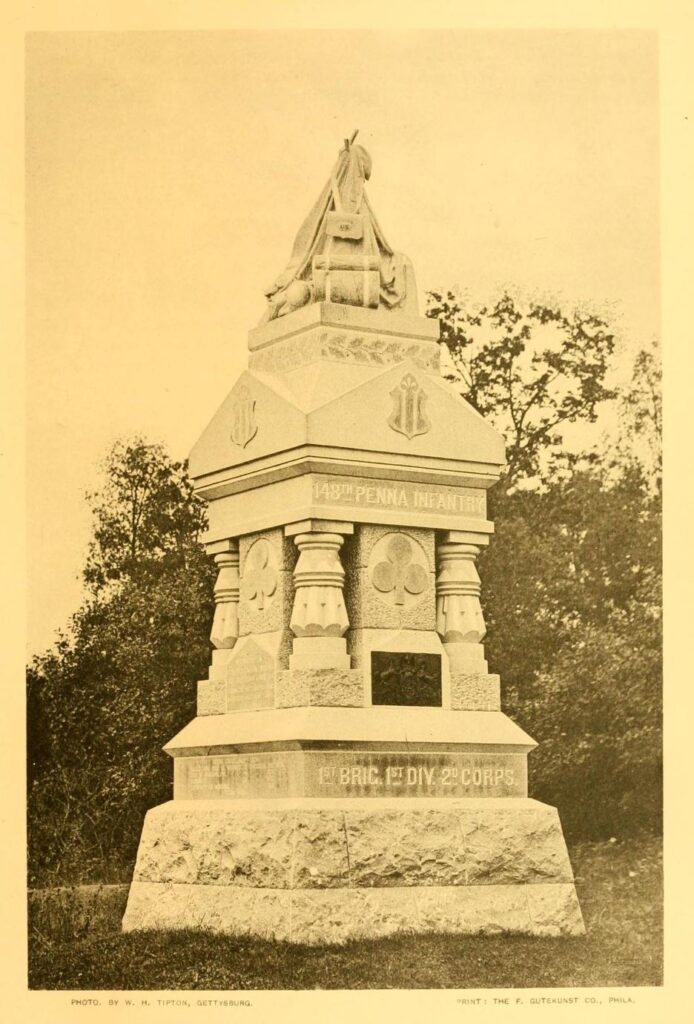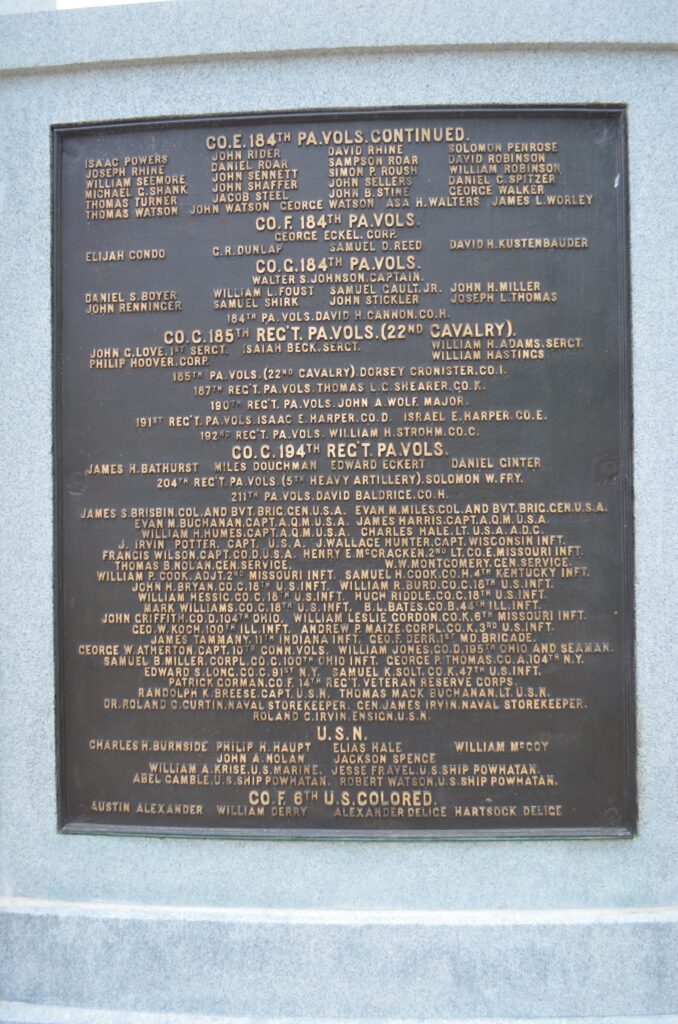“Such times and scenes were witnessed in this beautiful valley during these last two weeks were never before dreamt of much less imagined,” Samuel Gramly of Rebersburg wrote in a journal on August 31, 1862. A school teacher in Brush Valley, Gramly had marveled at the recruitment and enlistment of dozens of local men into the Union army. It was, indeed, “such times” throughout Centre County.
When Gramly recorded his thoughts, the Civil War was in its seventeenth month, having begun on April 12, 1861, with the firing by Confederates on Fort Sumter in the harbor of Charleston, South Carolina. At that time, seven Southern slaveholding states had seceded from the Union in the aftermath of Republican Abraham Lincoln’s election to the presidency in November 1860. Centre County voters had given Lincoln, a critic of slavery, a majority of 573 votes over the other three candidates. Bellefonte resident, Andrew Gregg Curtin, had been elected the Republican governor of Pennsylvania.
According to the U.S. Census, 27,000 men, women, and children lived in Centre County in 1860. Like their fellow countrymen, many residents watched closely the nation’s descent into civil conflict over the issue of slavery. With the surrender of Fort Sumter, Lincoln requested 75,000 volunteers to suppress the rebellion. Governor Curtin established a training camp for volunteers in Harrisburg and began preparations for organizing regiments in response to the president’s proclamation.

Patriotic fervor swept through the county during those momentous spring days and weeks. Less than a week after the attack on Fort Sumter, a crowd gathered for a meeting at the courthouse in Bellefonte. An eyewitness exclaimed that it was “one of the largest and most patriotic gatherings that has ever convened in this place.” Sixty-five attendees gave monetary subscriptions from $10 to $300 for the support of families of volunteers, pledging $4,438 in all. Days later, residents of Bellefonte raised $6,900 in three days to support families.
The county’s antebellum militia companies, meanwhile, began departing for the state capital. The Bellefonte Fencibles, Eagle Guards, Cameron Infantry, and Curtin Guards were assigned to three-month infantry regiments that were organizing in Harrisburg.
Volunteers in the Snow Shoe area formed a new militia company, and Frank W. Hess, a school teacher in Potter’s Mills, raised another company, which eventually became Company I of the 15th Pennsylvania Cavalry. On May 13, the Centre Guards were organized and were mustered in a month later as Company E, 34th Pennsylvania Infantry. Citizens also volunteered as home guards.

During the next year, hundreds of Centre County men enlisted in three-year infantry, cavalry, or artillery units. They traveled to Lewistown, where they boarded railroad cars for Harrisburg and the training camp named in honor of the governor, Camp Curtin.
The sprawling installation was located north and east of the capitol (just west of the modern-day Farm Show buildings). The volunteers were organized into companies — ten for an infantry regiment, twelve for a cavalry regiment — and then received minimal training before being sent south. Like the vast majority of volunteers, Centre County men enlisted primarily to restore the Union.
By July 1862, northern fortunes in the war had darkened, and Lincoln called for 300,000 more troops. In Pennsylvania, Curtin sought to fulfill the state’s quota with raising three-year units. On August 2, citizens gathered in a mass meeting in Bellefonte in which prominent businessmen and other wealthy individuals agreed to pay each recruit a bounty of $50 for enlisting. During most of August, “war meetings” were held in various towns and villages to have volunteers enroll.
On August 25, eighty-five men stood in Rebersburg’s main street and swore an oath of allegiance to the United States. Centre County raised seven companies in all — more than 700 volunteers. Along with companies from Jefferson, Indiana, and Clarion counties, they formed the 148th Pennsylvania Infantry, known as the “Centre County Regiment.” Curtin appointed James A. Beaver as the regiment’s colonel. The 148th Pennsylvania fought at Chancellorsville, Gettysburg, Wilderness, Spotsylvania Court House, Cold Harbor, and Petersburg until the conflict’s end.
At home in the county, families received and wrote letters to members in the service. Wives raised children and, if necessary, tended farms or businesses. In Rebersburg, Samuel Frank, owner of a dry goods store, acted as a local banker, extending credit until a soldier’s pay reached home and, if asked, oversaw financial affairs of folks. Men like Frank in other towns and villages supported the cause in their own manner. Northern citizens benefited from a relative prosperity brought by the conflict.

Voices of dissent against the policies of the Lincoln administration arose, however, in the county. When Congress passed a conscription or draft law in 1863, crowds marched to the courthouse and protested. Local lore relates of men avoiding the draft by hiding in the mountains while cared for by family members for months.
At least twenty-eight Black residents of the county served regiments in the U.S. Army comprised mainly of African American soldiers. Many served in the 6th U.S. Colored Infantry Regiment, which saw action at Richmond and New Market Heights, Virginia, and several died in action. Twenty-one of the men who served are listed on the county’s Soldiers and Sailors Memorial. Some are buried in Union Cemetery in Bellefonte.
Peter Gray Meek, editor and publisher of the Democratic Watchman in Bellefonte, was arrested five times during the war for his criticisms of the federal government. Authorities, however, never prosecuted Meek for the alleged crimes of treason and for discouraging enlistments.
By the war’s end in April and May 1865, approximately 3,700 Centre County residents had served in more than forty infantry, cavalry, and artillery units, the overwhelming majority in three-year regiments. Many were wounded or killed. In the decades after the conflict, the surviving veterans attended local reunions and joined Grand Army of the Republic (GAR) posts in towns.
In 1906, the veterans gathered in front of the courthouse in Bellefonte for the dedication of the Andrew Gregg Curtin monument and the Soldiers and Sailors Memorial, designed by Joseph M. Huston. The memorial contains the names of the Centre County men who served in the Civil War and Spanish-American War. There is a monument that stands as a silent sentry beside the Main Street in Rebersburg, which commemorates the August 1862 day when eighty-five volunteers swore the oath of allegiance to the United States.
Jeffry Wert
Sources:
“Bellefonte historical monument to be repaired and preserved,” Centre Daily Times, May 23, 2017.
Samuel Gramly, Journals. Privately Printed, n.d.
Linn, John Blair. History of Centre and Clinton Counties, Pennsylvania. Philadelphia: L.H. Everts, 1883.
First Published: May 20, 2021
Last Modified: March 29, 2024
